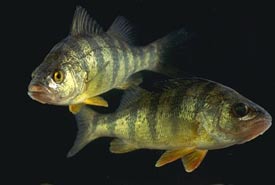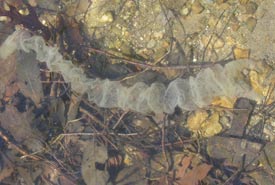In praise of perch power

Yellow perch swimming (Photo by USDA)
When I was 10 years old, I spent my first morning on Lake Erie reeling in yellow perch. By early afternoon, we caught our legal limit, and I found out first-hand why these little striped bandits are a great way to introduce kids to fishing and conservation.
A member of the widespread Percidae family, the yellow perch occurs throughout much of Canada and the northern United States. Its range extends east from Nova Scotia, through the Great Lakes region, all the way to British Columbia. Sparser populations of perch even inhabit the Great Slave and Great Bear Lakes in the Northwest Territories.
Depending on the locale, perch are known by different names, including coon perch, striped perch, jack perch and “perchaude” in Quebec.

Yellow perch (Illustration by New York Deptartment of Environmental Conservation)
Yellow perch are a green- to yellowish-gold in colour, with six to eight distinct dark bars on their backs. When breeding, they sport bright orange lower fins that stand out against their snow-white bellies. Mature specimens have a noticeable humpback.
Most anglers catch perch ranging from six to 10 inches in length and weighing a quarter to three quarters of a pound. In larger lakes such as the Great Lakes, abundant space and food sources result in "jumbo" perch that weigh on average one to two pounds and reach 16 inches in length. The oldest freshwater fish record is a four-pound, three-ounce yellow perch caught in New Jersey in 1865.
A schooling species (swimming in a large groups as opposed to solitary swimming), perch are usually found in larger lakes with warm or cool waters, in addition to open areas with gravelly bottoms.

Perch eggs (Photo by Lake Sagamore Community Association)
Yellow perch spawn in the spring. Females lay eggs in gelatinous ribbons that can be seven feet long and contain between 23,000 and 40,000 eggs. The egg ribbons attach to plants, after which males gather to fertilize the eggs. Young perch dine on plankton before graduating to insects, fish eggs, juvenile fish and crustaceans.
Despite their wide range, yellow perch are most often associated with Canada’s larger water bodies such as the Great Lakes, Lake Winnipeg and Lake Simcoe. According to a 2005 survey by Fisheries and Oceans Canada, yellow perch were the most commonly harvested sport fish in the Great Lakes (representing 32 percent of the total fish harvest), and anglers continue to catch them in huge numbers every year.
Beyond sport fishing, fisheries have commercially harvested yellow perch in the Great Lakes for over 100 years. The species remains one of Canada's most important freshwater commercial species. In 2002, for example, Canadian fisheries harvested an estimated 3,622 tonnes of perch, valued at nearly $167 million. In Ontario, perch are the most important commercial catch. Demand for Lake Erie perch meat continues to be high, as evidenced by a rise in Ontario prices earlier this year.
Yet despite the yellow perch's omnipresence in the Great Lakes, populations can be volatile. Perch are prolific breeders, and unrestricted population growth depletes their food supply and causes their bodies to shrink in a process known as stunting. This results in large populations of small fish in smaller bodies of water such as Nova Scotia’s Long Lake, where stunted perch can crowd out other species.
In the Great Lakes, stunting isn't really an issue, but perch are nonetheless susceptible to population declines due to climate change, predation, pollution and invasive species.
Lake Michigan's perch population has declined in recent decades due to poor survival rates of young fish and changes to the lake's food web caused by invasive zebra mussels. In 1990s and early 2000s, some of Lake Ontario's perch may have declined due to predation by cormorants. Climate change also threatens Great Lakes perch. Researchers at Ohio State University recently found that warmer winters have resulted in decreased numbers of juvenile perch in Lake Erie.

Lake Ontario (Photo courtesy of Bob Linsdell)
Potential threats to perch and other fish populations in the Great Lakes have spurred key conservation initiatives. In 2014, the Fishery Management Agencies of Lake Michigan organized a Yellow Perch Summit to discuss strategies to help the lake’s perch population rebound. Restoring native fish is also a key component of Ontario’s 2016 Great Lakes Strategy, which involves studying food webs (“what eats what”) to learn more about the habits of predatory and prey species. This will have direct repercussions for managing yellow perch, a fish that falls into both camps.
Moreover, the Biodiversity Conservation Strategy for the Great Lakes also includes strategies for native fish restoration that focus on predators and mid-level prey.
Yellow perch are a major Great Lakes sport and commercial species, and a vital part of the lakes' ecosystems. They serve as food for larger fish such as walleye, trout and salmon. Hopefully, continued conservation efforts will ensure that the perch remains a Great Lakes icon for generations to come.


